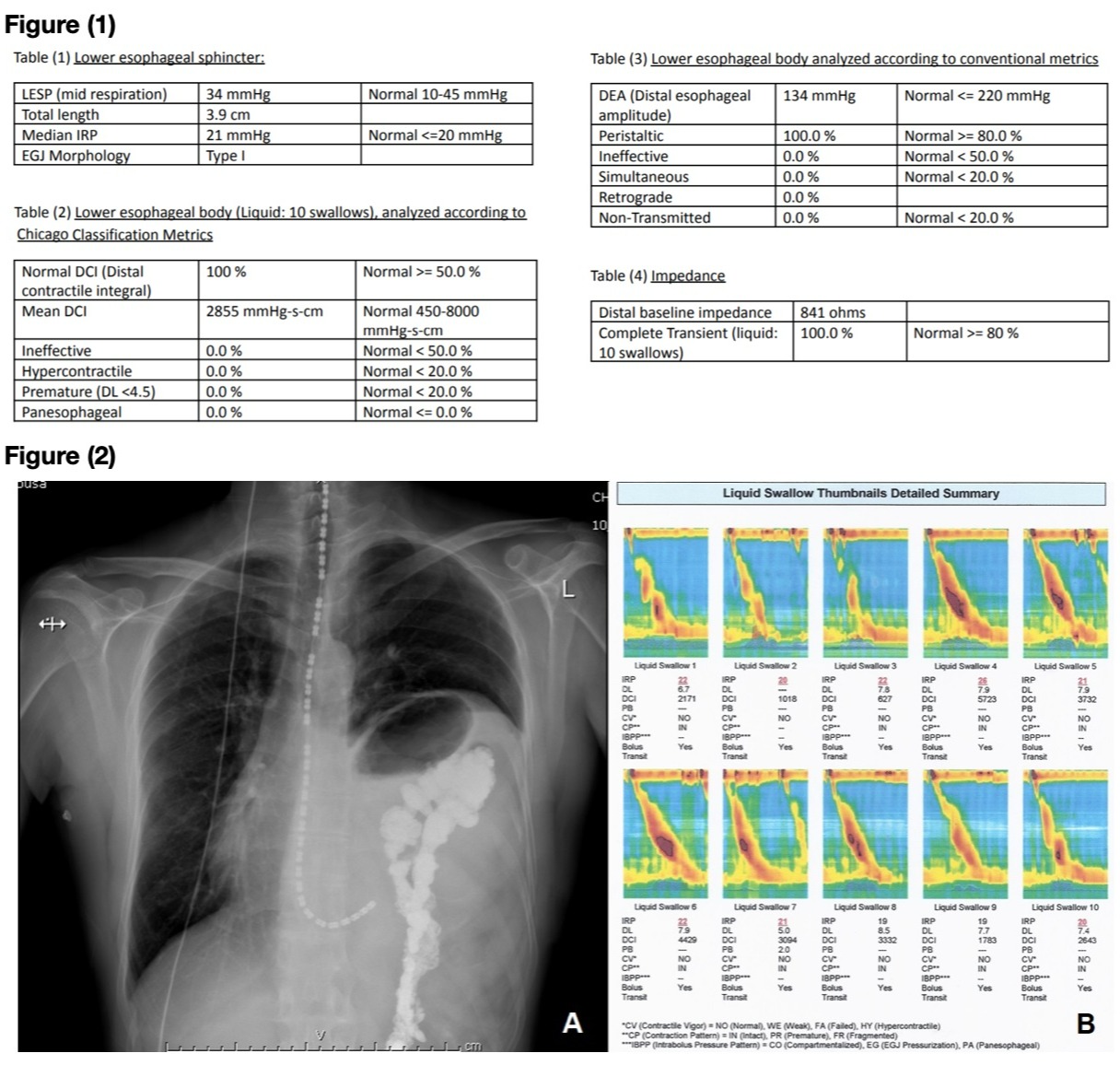Back
Poster Session A - Sunday Afternoon
Category: Esophagus
A0235 - A Motility Study in a Patient With Isolated Diaphragmatic Agenesis: An Interesting Study in a Very Rare Entity!
Sunday, October 23, 2022
5:00 PM – 7:00 PM ET
Location: Crown Ballroom
- RA
Rawan Aljaras, MD
Indiana University School of Medicine
Indianapolis, Indiana
Presenting Author(s)
Noor Abu-Farsakh, MD1, Eleazar E. Montalvan-Sanchez, MD2, Renato Beas, MD3, Diego Veraza, MD2, Rawan Aljaras, MD2
1Jordan University Hospital, Amman, 'Amman, Jordan; 2Indiana University School of Medicine, Indianapolis, IN; 3Indiana University, Indianapolis, IN
Introduction: Diaphragmatic agenesis is a very rare congenital defect. Diagnosis is typically made in infancy and it is commonly associated with other congenital malformations and high mortality. However, it has also been described in the literature as a distinct clinical entity with potentially later in life diagnosis, as in the case reported here.
Case Description/Methods: Our subject is a 57-year-old male who was diagnosed to have diaphragmatic agenesis at the age of 45 during a thoracotomy for a suspected diaphragmatic hernia. He presented to the gastroenterology clinic with a chief complaint of life-long intermittent but progressive dysphagia to both solids and liquids. Chest x-ray showed bowel loops and air-fluid level in the left-side of the chest with a cardiac and a mediastinal shift to the right side. Barium swallow was done and was negative for any abnormalities. A motility study was also done and with details showing in attached figure (1). Findings of the motility study are summarized as the following: 1) Normal resting pressure at lower esophageal sphincter with incomplete relaxation during swallows (high IRP), 2) Normal amplitude peristaltic contractions in esophageal body (Normal DCI), 3) Complete bolus transition, 4) Esophagogastric morphology I, and 5) Normal upper esophageal sphincter resting pressure. A chest X-ray obtained and attached in figure (2A) shows the position of the probe used in the esophageal manometry with the gastroesophageal junction in the thoracic cavity. Figure (2B) shows our patient's manometric study evaluating pressure changes that occurred during liquid swallowing. The diagnosis of esophagogastric junction (EGJ) outflow obstruction was made based on study results.
Discussion: Esophagogastric junction outflow obstruction is a major motility disorder based on the Chicago Classification of esophageal motility disorders. This entity involves a heterogenous group of underlying etiologies with diaphragmatic agenesis being one potential but rare cause evidenced by our reported case. Management of (EGJ) outflow obstruction is dependent on the underlying etiology.

Disclosures:
Noor Abu-Farsakh, MD1, Eleazar E. Montalvan-Sanchez, MD2, Renato Beas, MD3, Diego Veraza, MD2, Rawan Aljaras, MD2. A0235 - A Motility Study in a Patient With Isolated Diaphragmatic Agenesis: An Interesting Study in a Very Rare Entity!, ACG 2022 Annual Scientific Meeting Abstracts. Charlotte, NC: American College of Gastroenterology.
1Jordan University Hospital, Amman, 'Amman, Jordan; 2Indiana University School of Medicine, Indianapolis, IN; 3Indiana University, Indianapolis, IN
Introduction: Diaphragmatic agenesis is a very rare congenital defect. Diagnosis is typically made in infancy and it is commonly associated with other congenital malformations and high mortality. However, it has also been described in the literature as a distinct clinical entity with potentially later in life diagnosis, as in the case reported here.
Case Description/Methods: Our subject is a 57-year-old male who was diagnosed to have diaphragmatic agenesis at the age of 45 during a thoracotomy for a suspected diaphragmatic hernia. He presented to the gastroenterology clinic with a chief complaint of life-long intermittent but progressive dysphagia to both solids and liquids. Chest x-ray showed bowel loops and air-fluid level in the left-side of the chest with a cardiac and a mediastinal shift to the right side. Barium swallow was done and was negative for any abnormalities. A motility study was also done and with details showing in attached figure (1). Findings of the motility study are summarized as the following: 1) Normal resting pressure at lower esophageal sphincter with incomplete relaxation during swallows (high IRP), 2) Normal amplitude peristaltic contractions in esophageal body (Normal DCI), 3) Complete bolus transition, 4) Esophagogastric morphology I, and 5) Normal upper esophageal sphincter resting pressure. A chest X-ray obtained and attached in figure (2A) shows the position of the probe used in the esophageal manometry with the gastroesophageal junction in the thoracic cavity. Figure (2B) shows our patient's manometric study evaluating pressure changes that occurred during liquid swallowing. The diagnosis of esophagogastric junction (EGJ) outflow obstruction was made based on study results.
Discussion: Esophagogastric junction outflow obstruction is a major motility disorder based on the Chicago Classification of esophageal motility disorders. This entity involves a heterogenous group of underlying etiologies with diaphragmatic agenesis being one potential but rare cause evidenced by our reported case. Management of (EGJ) outflow obstruction is dependent on the underlying etiology.

Figure: Figure (1) Motility study details.
Figure (2A) Chest Xray showing the position of the probe used in the esophageal manometry.
Figure (2B) Patient's manometric study evaluating pressure changes that occurred during liquid swallowing.
Figure (2A) Chest Xray showing the position of the probe used in the esophageal manometry.
Figure (2B) Patient's manometric study evaluating pressure changes that occurred during liquid swallowing.
Disclosures:
Noor Abu-Farsakh indicated no relevant financial relationships.
Noor Abu-Farsakh — NO DISCLOSURE DATA.
Eleazar Montalvan-Sanchez indicated no relevant financial relationships.
Renato Beas indicated no relevant financial relationships.
Diego Veraza indicated no relevant financial relationships.
Rawan Aljaras indicated no relevant financial relationships.
Noor Abu-Farsakh, MD1, Eleazar E. Montalvan-Sanchez, MD2, Renato Beas, MD3, Diego Veraza, MD2, Rawan Aljaras, MD2. A0235 - A Motility Study in a Patient With Isolated Diaphragmatic Agenesis: An Interesting Study in a Very Rare Entity!, ACG 2022 Annual Scientific Meeting Abstracts. Charlotte, NC: American College of Gastroenterology.
